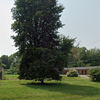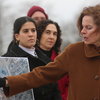Guidelines require school staff to make judgments under fire
“During that time, you’re on your own,” said Captain Daniel McNally of the Guilderland Police.
He was referring to the minutes between a 9-1-1 call and the arrival of police. The national average is said to be three minutes, he said, “but I would argue it’s more than that.”
McNally was talking to a group of more than 100 people gathered at Guilderland Town Hall Tuesday night for a training course for civilians, about what they should do if caught in an active-shooter situation.
The course is currently being taught by law enforcement to other police, emergency medical workers, and citizens across the country. The protocol it teaches is referred to as “Run, hide, fight.”
It advocates, as the best line of defense, when possible, running away from the scene and calling 9-1-1. The next best response, it says, is denying entry to the shooter by locking doors, turning off lights, and hiding, while the third and last resort is to fight in an effort to overpower the attacker and save lives.
Local schools, however, are sticking to the more traditional approach of locking down and staying put.
Federal guidelines
The United States Department of Education came up with active-shooter guidelines in 2013, said David Esquith, director of the department’s Office of Safe and Healthy Students.
The guidelines were written in response to the shootings at Sandy Hook Elementary School in Newtown, Connecticut. After the shootings, he said, President Barack Obama issued a plan called “Now Is the Time”; as one element in his plan, he charged the departments of Education, Justice, Health and Human Services, and Homeland Security with creating a set of guidelines on the best ways for schools to handle active-shooter incidents.
So they did. Working together and with the Federal Bureau of Investigation and the Federal Emergency Management Agency, they wrote a section on active-shooter situations as part of their “Guide for Developing High-Quality Emergency Operations Plans for Institutions of Higher Learning,” Esquith said.
These guidelines suggest that schools also adopt “run, hide, fight.”
Need for decisiveness
The goal of Tuesday’s class, McNally told residents, is to empower them to be able to respond decisively in an emergency.
The first problem people have to overcome, he said, is their own “normalcy bias.” They hear gunshots, but think to themselves, “It’s probably firecrackers.” Or they see fire near the stage at a concert and think, “It must be part of the show.” The important thing, he said, is to speed up the time it takes them to recognize an emergency.
McNally noted that stress causes the heart to beat much faster, which causes difficulty with, first, fine motor skills such as fitting a key into a lock and later with gross motor skills, such as moving a chair in front of a door.
He emphasized the need for slow and deliberate breathing — “combat breathing” — to slow the heart rate, and for decisive action and follow-through.
“If you’re going to run, you run all the way,” he said. “If you’re going to lock the door, you do it. If you’re going to fight, you don’t fight fair, it’s all-out.”
Judgment required
Local school leaders confirmed that lockdown and sheltering is the protocol on which they rely.
Meanwhile, Esquith told The Enterprise that for over two years the department has been advocating for the use of the “Run, hide, fight” protocol in schools.
“This is a much more complicated decision tree than what has been the traditional approach to active shooter incidents, and we recognize that,” he said.
Asking adults in charge of children to make decisions in a high-stress situation about whether running might be best for a particular group of students and a particular emergency situation “involves a lot of judgment as to, number one, should you run, and, number two, where’s a safe location,” he said.
The protocol says, Esquith explained, that if it is safe for yourself and others in your care, the first course of action is to run out of the building and far away, until you are in a safe location.
That introductory clause about “if it is safe,” is really important, he said. The adult in that situation has to make a judgment. “And if there’s any question about whether it is safe to do so, then you kick to Step 2: If running is not a safe option, hide in as safe a place as possible.”
Esquith was asked about a hypothetical situation in which a gunman moves through a school, methodically shooting people in each classroom. In that case, wouldn’t it be better to run, he was asked.
“In that scenario, yes, hiding is not the best option,” he said, “but there are scenarios in which it is the best option. That’s why all of this is so complicated.”
Esquith noted that there are “many, many, many schools” that still use the protocol of lockdown without ever considering running or the third protocol, in which a responsible adult can make the individual decision to try to fight and overpower an attacker.
The guidelines say that it may be necessary, in the same active-shooter event, to use more than one option.
Run, hide, fight
Training staff and students to respond immediately is crucial, the guidelines say, stating that announcements should “forcefully communicate the danger and necessary action (e.g., ‘Gun! Get out!’).”
Here’s what the federal guidelines advise on each component:
— Run: “If it is safe to do, the first course of action that should be taken is to run out of the building and move far away until you are in a safe location,” the guidelines say.
Students and staff should be trained to leave personal belongings behind; visualize possible escape routes including physically accessible routes for those with disabilities; take others with them but not stay behind because others will not go; call 911 when safe to do so; and let a responsible adult know where they are.
— Hide: If running is not a safe option, students and staff should be trained to hide where walls may be thicker and there are fewer windows.
They should: lock doors; barricade doors with heavy furniture; close, lock, and cover windows; turn off lights; silence electronic devices; hide along a wall close to the exit but not visible from the hallway; silently communicate with first responders (for example, through a window) if possible; and remain in place until given an all-clear by law enforcement.
— Fight: When neither running nor hiding are safe options, “adults in immediate danger should consider trying to disrupt or incapacitate the shooter by using aggressive force and items in their environment, such as fire extinguishers, chairs, etc.,” the guidelines say.
Employees should never be required to confront a shooter, the guidelines say, and the possibility of an active shooter situation “is not justification for the presence of firearms on campus in the hands of any personnel other than law enforcement.”
Upcoming drill
Brian Hunt, superintendent of the Voorheesville School District, said that the district is planning an active-shooter drill for March 24, at the high school. That date is also a parent-teacher conference day, and students will not be present.
People will play the role of students, he said. The drill will involve the Albany County Sheriff’s Office, the New York State Police, and first responders.
Hunt said the drill will test the protocols in place in the school district, including a system in which the school’s cameras can be accessed in an emergency by the Albany County Sheriff’s Office at its substation in Clarksville.
He said that the district’s current policy relies on the idea of placing the school on lockdown in the event of emergencies including an active shooter incident.
The school district is currently working on trying to upgrade the entryways by installing double doors on all school buildings. Hunt said on Tuesday, “That is part of our Smart School bond proposal that was approved by the board last night. We will need to go through the State Education Department approval process to get this going. It will take some time to get that, but eventually we’re going to have that.” He noted that Smart Schools is a state program that provides 100 percent reimbursement for school technology upgrades and security upgrades.
He said that the Albany County Sheriff’s Office has received a grant from Homeland Security to contract with security consulting firm Tetra Tech to help the Voorheesville School District with safety protocols. The March 24 drill will be part of the district’s work with the sheriff’s office to expand and improve safety protocols.
He had not heard of the Department of Education’s guide, but said that he would discuss it with the experts advising Voorheesville.
State Police do not advocate “Run, hide, fight”
Spokesman Beau Duffy of the New York State Police told The Enterprise that “Run, hide, fight” is being taught by the federal Department of Homeland Security, and is not something that New York State Police have adopted. Duffy noted that he was speaking for the captain of their Emergency Services Section, John Agresta.
“It’s something we’re looking at,” Duffy said. “We teach schools ‘lock down and lock out.’”
Through Duffy, Agresta said that one worrisome scenario would be a shooter who had not yet breached the building. “There could be multiple ways,” Duffy said, “that people leaving the building could run into the shooter.”
GCSD relies on lockdown
When asked about the Department of Education’s recommendation — that the best and first course of action in many instances should be to run — Neil Sanders, assistant superintendent for business at the Guilderland School District, said, “The advice that we have received from experts in the field is what we follow, which is to lock everybody in their rooms until released by police.”
The Guilderland district recently rebuilt the entryways of all seven schools, installing double doors, each with its own buzzer, and implemented other security measures. For instance, the school district now has a system in which Guilderland Police would be able, in an emergency, to access the school’s cameras.
Sanders said that the district had worked closely with law enforcement and first responders to make sure that they were familiar with school buildings and knew what school officials would do in an emergency, and so that school officials likewise knew what law enforcement would do.
“I’m not saying that we wouldn’t change [our protocol], but we would have to do a lot more research in terms of how that would work,” Sanders said.
“Every instance is different,” Guilderland Police Chief Carol Lawlor told The Enterprise. “I would assume that most times, while you try to follow the protocol you are taught, sometimes circumstances change, and you have to go another route.”


